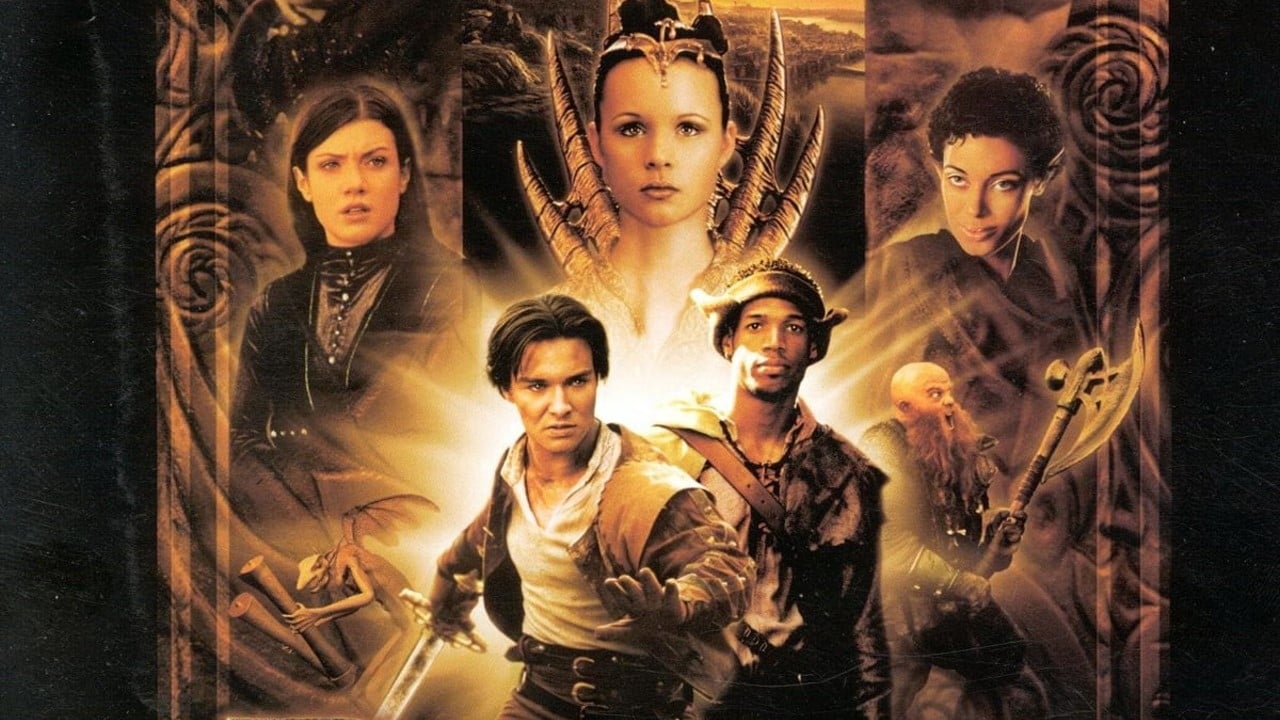
Dungeons & Dragons is a 2000 film written by Topper Lilien and Carroll Cartwright and directed by Courtney Solomon. Justin Whalin, Marlon Wayans, and Zoe McLellan star as a band of intrepid heroes, fighting to save the empire of Izmer from the machinations of the evil sorcerer Profion, played by Jeremy Irons. Dungeons & Dragons is rated 3.7 on IMDB, 14 on Metacritic, and 10% on Rotten Tomatoes. It is filled with laughably bad performances, poorly rendered effects, terrible costumes and makeup, and a dozen unnecessary subplots; and that’s what makes it so great!
In this analysis of Dungeons & Dragons, we will discuss the Importance of Meta-Textuality.
What is Meta-Textuality?
Meta-textuality, or “going beyond the text”, is a form of criticism where one piece of art makes commentary on another piece of art. However, in recent years, the term has been adopted and shortened to “meta” and more often describes art that is self-referential, with the artist actively commenting on some failing of the characters, plot, or genre. This irony often creates humor.
The simplest version of meta-textuality in film is parody. Robin Hood: Men in Tights takes time not only to criticize the many failings of Robin Hood: Prince of Thieves, but also itself, utilizing fourth wall breaks and visual gags; including one particularly funny moment where the characters themselves pull out the script and read it aloud. Parody is meta-textual by nature, but not all things “meta” are parody.
For example, Community is often referred to as “meta,” but the plot and the characters are original creations. How can something be “meta” if it’s not based on other works? What is important is not the art that is being commented on, but the commentary itself. The character Abed often acts as the audience avatar, pointing out when the plot becomes hackneyed and the characters become predictable. Community is not a criticism of a specific work, but a deconstruction of the sitcom genre. By utilizing and then lambasting popular genre tropes, Community regularly subverts audience expectations.
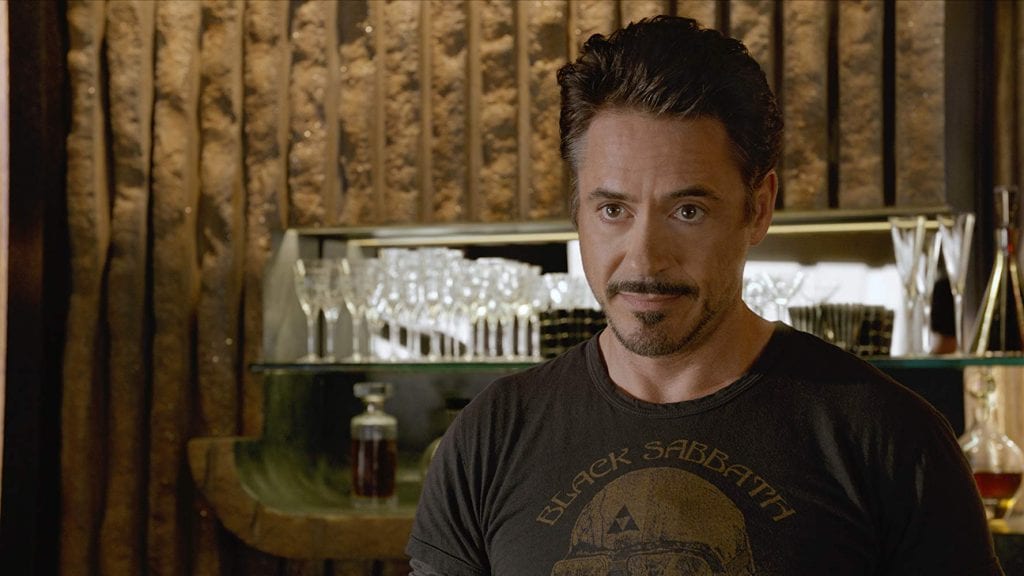
Meta-textuality doesn’t have to be overt to be effective. Joss Whedon is a master of meta-textuality, utilizing it with more subtlety than the likes of Dan Harmon and Mel Brooks. Take this popular dialogue from The Avengers:
Loki: The Chitauri are coming. Nothing will change that. What have I to fear?
Tony Stark: The Avengers. That’s what we call ourselves; we’re sort of like a team. “Earth’s Mightiest Heroes” type thing.
Loki: Yes, I’ve met them.
Tony Stark: Yeah, takes us a while to get any traction, I’ll give you that one. But let’s do a head count here: your brother the demi-god, a super soldier, a living legend who kind of lives up to the legend; a man with breathtaking anger management issues; a couple of master assassins, and YOU, big fella, you’ve managed to piss off every single one of them.
Loki: That was the plan.
Tony Stark: Not a great plan.
-The Avengers
Not only do we have a title-drop in this sequence, where Tony Stark refers to their group as the Avengers (which is surprising as many superhero movies fail to actually NAME the hero or group), but he also calls the entire plot into question, pointing out that Loki’s plan is terrible. This creates humor for the audience on two levels: 1) Loki’s plan is terrible, so it’s funny to see Tony make fun of him. 2) The screenplay fails to give Loki a good plan, so it’s funny to see the writers make fun of themselves.
Why Is Meta-Textuality Important?
Subtle nods to meta-textuality often add a more human element to fantastical stories, where the audience is expected to suspend their disbelief throughout. For instance, The X-Files utilizes a meta-textual tool called “lamp-shading.” Writers use this trick when they anticipate that certain elements of the story may not be palatable to viewers. To thwart any backlash from their audience, writers call attention to the problem (a character making an odd choice, an oft-repeated plot device, inconsistencies in the worldbuilding, etc.).
In The X-Files, Scully acts as the skeptic, which adds believability to the world, and she also acts as the moral compass. This means that if Mulder, the likeable hero, needs to do something out of character to move the plot forward, having Scully say, “Mulder, why are you doing this? This isn’t like you…” not only adds more depth to the character interaction but addresses the audience’s concerns directly.
Buffy the Vampire Slayer (another creation of Joss Whedon) expertly uses this device, not only to address audience concerns with the unbelievability of the Buffy-verse, but also to nod to Whedon’s favorite fallback clichés, which we enjoy because the humor feels self-deprecating. In Season 6, Buffy’s sister, Dawn, is kidnapped by a musical demon, who curses all around him to sing and dance until they combust. This is already unbelievable enough to warrant lamp-shading, but it is even harder to swallow due to the fact that this is the ten thousandth time that Dawn has needed rescue. The lamp-shading utilized at this moment is simple but very effective. When Buffy hears that her sister has been kidnapped, she remarks, “Dawn’s in trouble. Must be Tuesday.” This moment humanizes Buffy. We feel that she is just as bored with the endless machinations of this tired plot device as we are.
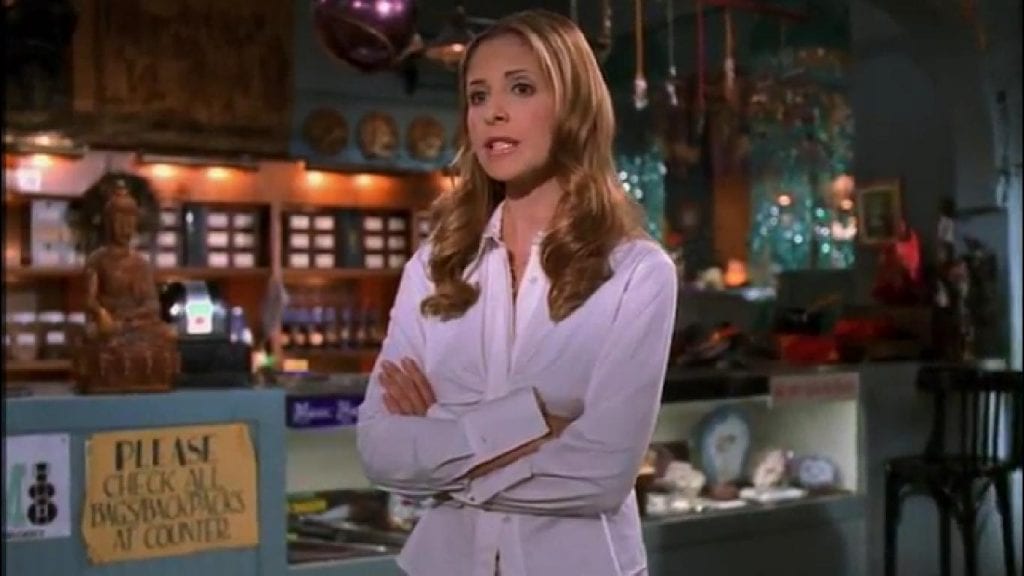
Lamp-shading should always be done with extreme care. After all, if your story requires lamp-shading to make sense, then the story might not be very good in the first place. But it is a useful tool when used in small quantities.
Finally, there is one more meta-textual trick that can add credibility and humor to your piece and may even go completely unnoticed by your audience. What do Titanic, John Dies at the End, The Princess Bride, and Deadpool have in common? They all use a framing device.
What is a Framing Device?
Grand Dame: I find your collection of folk tales quite brilliant, actually.
Jacob Grimm: Thank you.
Grand Dame: But I must say, I was terribly disturbed when I read your version of the little cinder girl.
Jacob Grimm: Well, there are those who swear that Perrault’s telling with its Fairy Godmother and magic pumpkins would be closer to the truth.
Wilhelm Grimm: Some claim the shoe was made of fur. Others insist it was glass. Well, I guess we’ll never know.
Jacob Grimm: Forgive me, Your Majesty, might I inquire about the painting? She’s really quite extraordinary.
Grand Dame: Her name was Danielle de Barbarac.
[Reaches inside the box the footman has brought to her.]
Grand Dame: And this… was her glass slipper… Perhaps you will allow me to set the record straight?
Wilhelm Grimm: Then it’s true, the story?
Grand Dame: Yes. Quite. Now then, what is that phrase you use? Oh, yes. Once upon a time, there lived a young girl who loved her father very much…
–Ever After: A Cinderella Story
A framing device is a storytelling technique in which a story is told inside of another story. There are key lines to look out for when trying to spot a framing device. Above, we see one of the most common: “Once upon a time”. Others may include “It all started when…” or “let’s go back to the beginning.” These lines are used when the framing device starts near the third act of the story (before or after) so that we, the audience, have a sense of the character and what drives them before the first act exposition. It also lends credibility to any sequence that follows because we are being told by an authority (usually the main character) that these events already happened. This makes fantastical elements much easier to accept.
For example, in John Dies at the End, it would be difficult for the audience to accept the first battle against a giant frozen meat monster if we hadn’t already seen our hero, Chase, use his telepathy to accurately describe a stranger’s dreams. That minor hint of magical realism makes everything that comes after much easier to swallow.
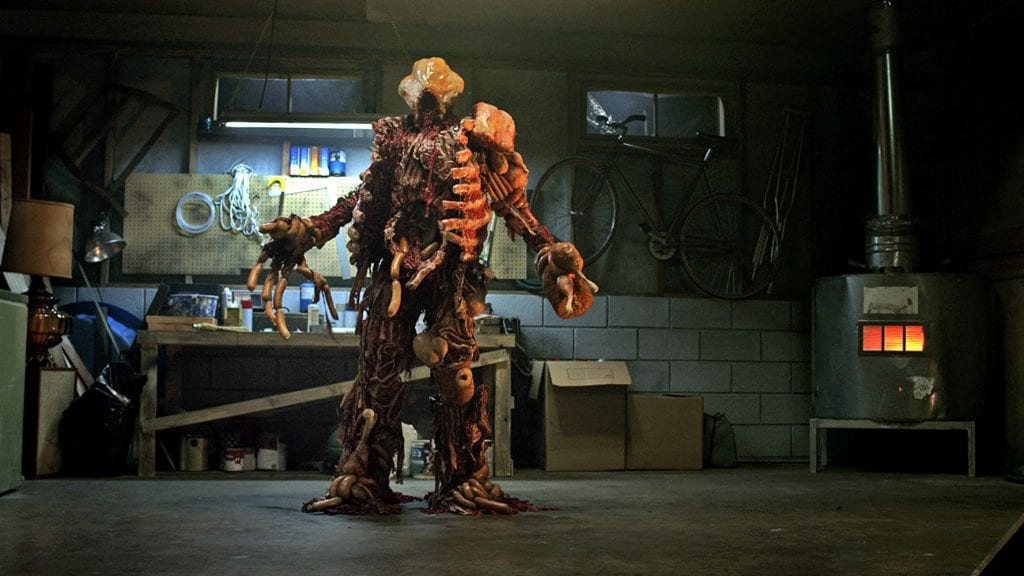
A well-edited film might often cut back and forth between the framing device and the main plot. For instance, in Forrest Gump, the framing device of Forrest telling his life story to strangers while waiting for the bus makes an appearance between each major sequence. This gives the audience a quick breather and reminds us that the events described have already happened. As the audience gets to know Forrest, the framing device also builds intrigue. Because Forrest’s life is so extraordinary, we can’t help but feel curious about where his bus will eventually take him. The payoff is even sweeter when our expectations are then subverted.
A good framing device will usually have a small story of its own to tell. In Titanic, Rose is finally able to make peace with her past. In The Princess Bride, a young boy bonds with his grandfather. The Princess Bride is interesting in that it is one of the few films where the framing device does not involve any of the main characters. The story itself is purely fictional, even in the reality of the movie.
What is Dungeons & Dragons?
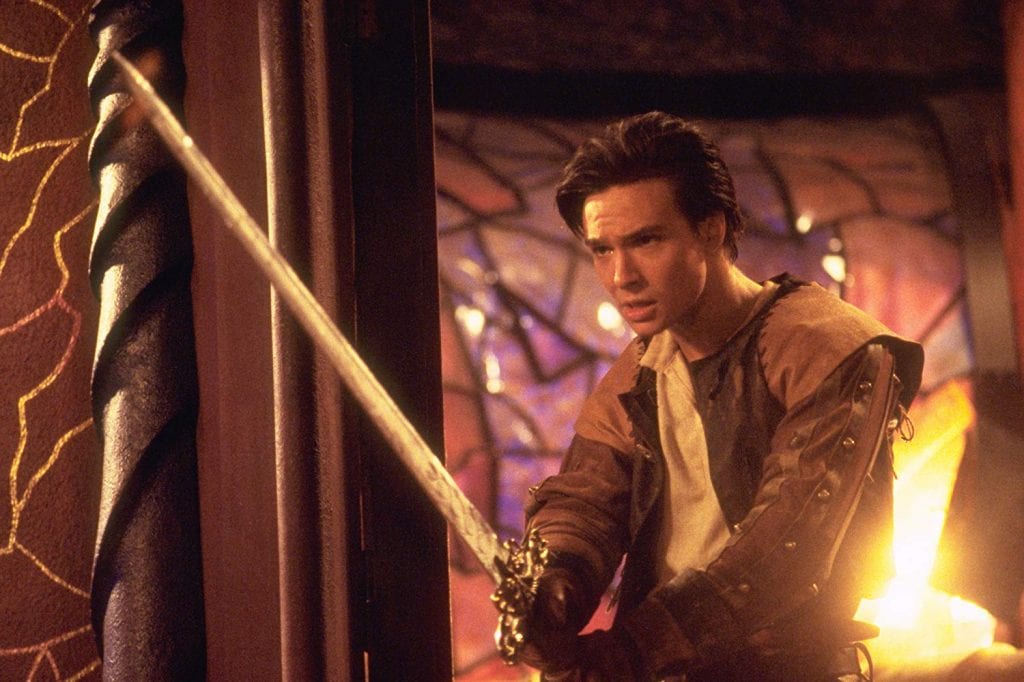
Dungeons & Dragons (D&D) is a tabletop role-playing game (RPG) in which players act out fantasy adventures using avatars, or Player Characters (PCs) that they have created. These adventures are directed and moderated by the DM (Dungeon Master) or GM (Game Master). Players choose classes and skills that give them advantages in some situations but may hinder them in others. Whenever luck may be involved in the proceedings, players roll dice to determine the outcome.
This description may sound intimidating, but the wonderful thing about D&D is that it requires very little in the way of actual skill. A novice player can have just as meaningful an experience as a veteran, as long as they keep an open mind. To enjoy Dungeons and Dragons, one needs only to bring their dice, imagination, and fighting spirit. The GM can help with the rest.
The fun of Dungeons & Dragons comes from a few factors. First, players can enjoy the empowerment that comes with being a hero (or even a villain, if the GM permits). Not only is D&D a great way to live out your personal power fantasy, but it is also a great way to explore what heroism means to you. Second, a good GM will cater adventures to their players’ needs. If one player loves puzzles and riddles, a good GM is sure to include those aspects to give that player an opportunity to shine.
Third, the mind is an incredible tool, and the power of imagination shouldn’t be discounted. Players can lose themselves in the fantasy, become genuinely invested, and allow themselves to have truly meaningful experiences. Fourth, working toward a common goal with your friends is just plain fun. D&D affords plenty of opportunities for hijinks, and jokes will abound. You’ll gain further insight into your friends and their values and share plenty of laughs as you seduce barmaids, befriend dwarves, defeat evil wizards, or just hang out at the tavern.
Is Dungeons & Dragons a good adaptation of the game?
This is the plot of Dungeons & Dragons:
Tim is a relatively new GM with lots of great ideas, and he has finally found a group of players who are committed to regular weekly sessions. Andy, Tim’s best friend, is clever and likes to imagine himself as a dashing hero, so he creates a rogue. Mark is Andy’s friend. Tim doesn’t know him very well, but he seems fun (if a little loud). Mark doesn’t really know anything about D&D, so he creates a rogue, like Andy. Andy also invites his girlfriend, Shannon. Shannon is very interested in D&D, and she’s already read through the Player’s Guide three times before the first gaming session. She’s a novice player, but she likes the idea of role-playing. She has chosen to play a mage.
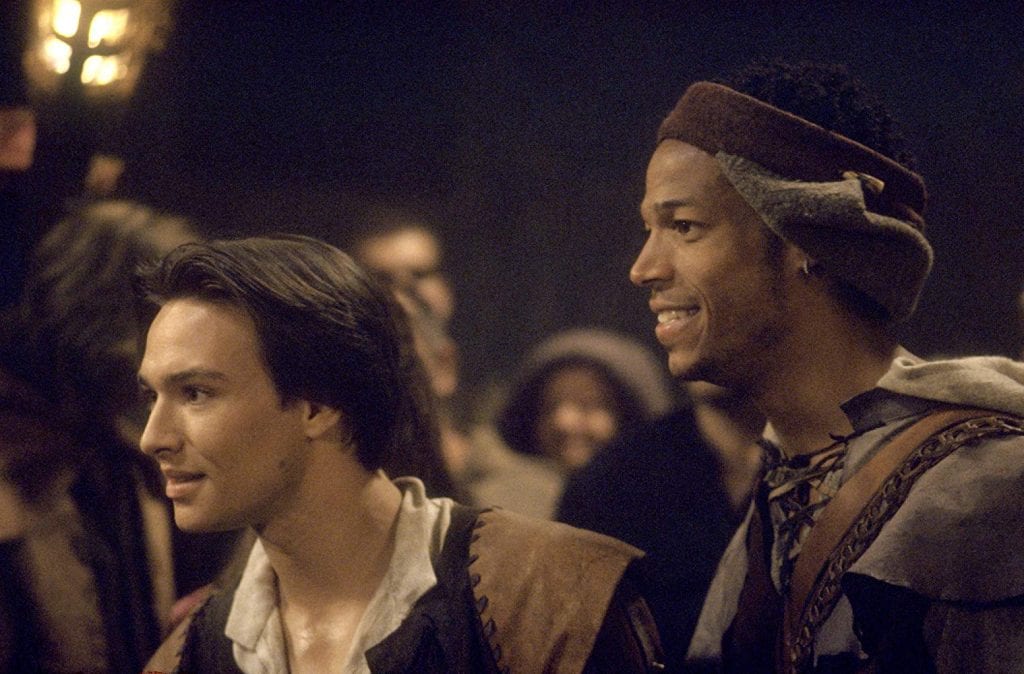
The first hurdle of the adventure comes from the party itself. Because none of the players choose to create fighters, Tim must create a plot that leans more on intrigue, traps, and puzzles instead of combat. Luckily, Tim manages to find a perfect module (a pre-made adventure that can be purchased). He is really excited because he put a lot of work into it, writing detailed character descriptions for each NPC (non-player character), and even coming up with distinctive voices for each of them.
Since the adventuring party is so small, Tim decides to play 2 NPCs to back up the group as needed. Their characters are already included in the module, so it shouldn’t take much effort to operate them. This creates a party of 3 PCs and 2 NPCs. It’s not ideal, but Tim is confident that he can make it work.
Tim guides his three players through the adventure, acting out each of the characters and trying to make time for each of the players to grow and develop. Tim even manages to sneak in a few easy enemy encounters to keep his players on their toes.
Unfortunately, things go awry pretty quickly. Tim finds it difficult to juggle the NPCs as well as his responsibilities as a GM and often forgets about them, which gives his players a major disadvantage during combat. Even more frustrating is that the party doesn’t seem interested in learning about the rich history of the world in which they are playing. Tim writes a lot of good dialogue for the villain and the Empress, but his players never get to hear any of it.
Everyone seems to be having a good time, but Mark (the Thief) is easily sidetracked and isn’t enjoying the main quest. Instead, he spends an exasperatingly long amount of time trying to charm a female elf NPC and complaining that they aren’t stealing things. This not only gets on Tim’s nerves but Shannon’s too, and her Mage character is having none of it. At the penultimate session, Mark informs the group that he has made other plans and won’t be available for the finale. In a petty act of revenge, Tim kills off Mark’s character, causing a rift in the group.
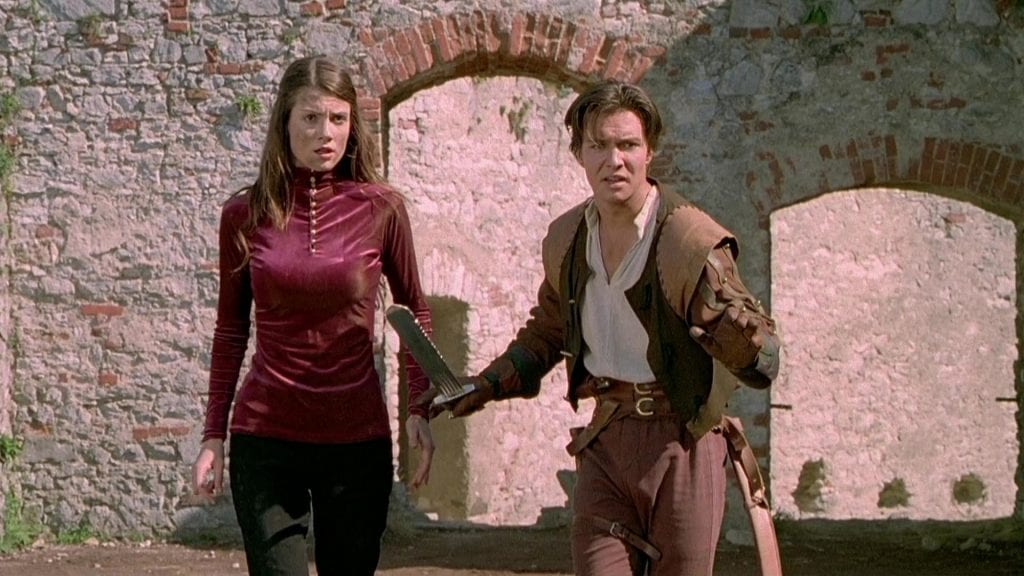
Despite the issues, Andy and Shannon finish the adventure and agree that they had a good time overall, and the players decide that they want to continue with a new campaign. Mark and Tim bury the hatchet when Mark apologizes for not being a team player and Tim apologizes for being so controlling. Both seem to have learned a valuable lesson about collective storytelling. With the party restored, the adventure ends on a cliffhanger, the promise of the next call to action right around the corner.
There’s only one problem: none of this is in the movie.
What is Dungeons & Dragons Actually About?
“The Empire of Izmer has long been a divided land. The Mages – an elite group of magic-users – rule whilst the lowly commoners are powerless. Izmer’s young Empress, Savina, wants equality and prosperity for all, but the evil Mage Profion is plotting to depose her and establish his own rule. The Empress possesses a scepter which controls Izmer’s Golden Dragons. To challenge her rule, Profion must have the scepter, and tricks the Council of Mages into believing Savina is unfit to hold it. Knowing that Profion will bring death and destruction to Izmer, Savina must find the legendary Rod of Savrille, a mythical rod that has the power to control Red Dragons, a species even mightier than the Gold.
Enter two thieves, Ridley and Snails, who unwittingly become instrumental in Savina’s search for the Rod. Joined by a feisty Dwarf named Elwood, and helped by the Empress’s expert tracker, the Elf Norda, the young heroes go in search of the Rod of Savrille. From the deadly maze of the Thieves Guild at Antius to an Elven Village, secret grotto and abandoned castles, Ridley and his band must outwit Profion’s chief henchman Damodar at every turn while, back in Izmer, Profion prepares to do battle with the Empress. All depends on the Rod, but the outcome of the race to reach it first is far from certain, and Izmer’s very survival hangs in the balance.”
-Wizards of the Coast (Publishers of the tabletop RPG Dungeons & Dragons)
This is the official plot synopsis of the movie, but it reads exactly like a module description. Notice that the synopsis doesn’t discuss any action, instead focusing on the backstory, the multiple settings, and notable loot.
In fact, it’s a safe bet that at least one of the film writers is an experienced GM. Furthermore, I think the screenplay of the film Dungeons & Dragons is based on a campaign that they actually played. It’s also interesting that one of the three main characters, the Mage Marina, is completely absent from the plot synopsis. This, I think, supports my theory that the movie is based on a real-life D&D campaign and that Marina was a later addition who was not originally included in the module.
How would Dungeons & Dragons benefit from Meta-Textuality?
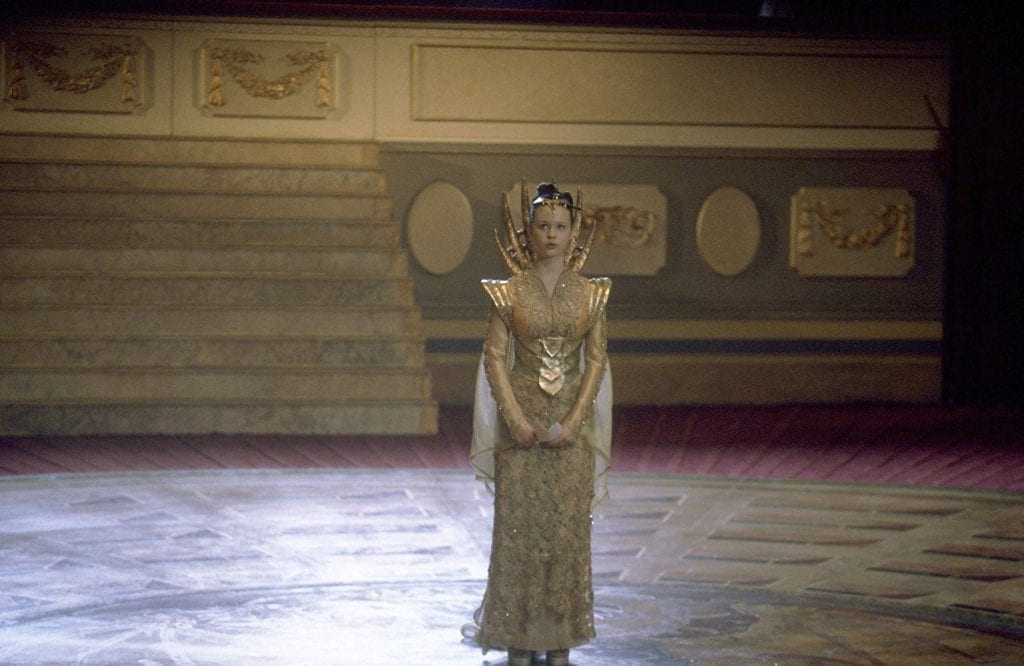
Any successful adaptation of Dungeons & Dragons must be meta-textual. This is because of the interactive nature of the game itself. Because the film Dungeons & Dragons has no framing device and never addresses the non-reality of the situation, nor the fact that the actions of the characters are determined by players in the real world, the film fails to capture anything that FEELS like D&D.
What Dungeons & Dragons needs more than anything else is a framing device. Let’s re-work a particularly unfunny moment of slapstick in the first scene to see if we can get better results:
[Four young adults sit at a small dining room table. The lights are dim, and eerie music plays in the background. Tim sits at the head of the table, surrounded by D&D paraphernalia, his Dungeon Master’s Guide and Player’s Handbook stacked on the floor beside him. A flimsy piece of cardboard partially obscures his face and completely hides his right hand, which is poised above an assortment of dice, ready for the first roll.]
Tim (GM): The Empire of Izmer is beautiful and prosperous, but it is ruled by a cruel council of mages, who believe that all non-magic users are second-class citizens. There are rumors that the Empress Savina is fighting to liberate the oppressed lower classes, but as far as most peasants can tell, things are worse now than ever before, especially with the sorcerer Profion’s army scouring the land and imprisoning innocents. The people live in fear of Profion’s most trusted Commander, the Dark Paladin Damodar, who was once a voice for the people but now stands as their greatest oppressor… The new moon creates no light on this cold autumn night, but the lights from the Mage Academy can be seen from miles away, casting an eerie glow over the capital city.
[As Tim describes the setting, an image fades in on the screen, becoming more detailed and pronounced as he speaks. This is the Empire of Izmeer, beautiful but intimidating. We cut back to the D&D table.]
Tim (GM): Here we find two thieves, Ridley and Snails, ready to begin the night’s adventures. Why don’t you tell us about yourselves?
Andy (Ridley): Hi, I’m Ridley. I’m a thief by trade, but a hero by design. High strength, high dex. Plus, I have a charisma of 16, so I’m pretty hot. Think of me as Han Solo.
[Andy winks at Shannon, who rolls her eyes.]
Mark (Snails): I’m Snails. I’m a thief too, but I’m no hero. I’m all about street smarts and outwitting the enemy.
Shannon (Marina): What’s your intelligence?
Mark (Snails): Uhhh…. Looks like it’s a… 9?
[Shannon and Andy snigger.]
Mark (Snails): What, is that bad?
[Cut back to Izmer, and 2 heroes have appeared on screen. We hear Tim’s narration through voiceover.]
Tim (GM): Suddenly, an all-engulfing inferno bellows from the depths beneath the Mage Academy, swallowing everything in its path and even lighting the usually calm waters around the capital with unnatural purple flames. What do you do?
Mark (Snails): Looks like some mage crap to me.
Andy (Ridley): I want to see what’s in that Mage School.
Mark (Snails): Dude, how are we gonna sneak in there? It’s probably filled with guards and wizards and stuff [Mark looks at Tim] … Is it?
Tim (GM): Oh yeah. The mage school is swarming with guards. You can see six guards waiting at the entrance to the school. They’re checking everyone’s mage credentials as they enter.
Andy (Ridley): What if we climbed up the wall and snuck in through a window?
Tim (GM) [rolls dice]: It’s possible. There are windows on the tenth floor. Do you want to try to climb the tower? You’ll need to roll a 15 or higher.
Andy (Ridley): Hell yeah! I want to see what kind of awesome loot they have in there!
Mark (Snails): Good point. [Rolls dice.] 17, baby!
Tim (GM): You don’t want to investigate the fire?
Andy (Ridley): No, that’s not really our problem. [Rolls dice.] I got a 16.
Tim (GM) [Shuffling papers around in frustration]: Okay, you climb in through the window. It’s like an 8-foot drop, so you’ll need to jump down.
Andy (Ridley): No problem, I’ve got a super high jump skill.
Tim (GM): Okay, roll your jump.
Andy (Ridley): 12 plus 6.
Tim (GM): You land like a graceful gazelle.
Mark (Snails): My jump skill is -2….
Andy (Ridley): Can I catch him if he falls?
Tim (GM): Sure thing. Snails, roll a jump check. Ridley, roll a dexterity check.
Mark (Snails): [Rolls dice.] I got a 5.
Shannon (Marina): Minus 2.
Mark (Snails): I got a 3.
Tim (GM): Well, you definitely fall. Ridley, what did you roll?
[Andy looks down in horror at his 20-sided die. Shannon looks over his shoulder and laughs out loud.]
Andy (Ridley): I rolled a 1.
Tim (GM): Just as Snails is making one of the worst jumps in thieving history, Ridley is distracted by a loud bang from the other room.
[Snails swan dives from the window and collides with Ridley, knocking them both to the floor.]
Tim (GM): Snails, you take… [rolls dice] 4 points of damage.
That scene took just as much time as the initial opening sequence, but instead of sitting through pointless banter, the audience now gets an idea for what motivates these characters and how they will interact. It’s not perfect, but it’s a vast improvement.
The Framing Device As Character Development
This framing device will allow for more flexible in-universe logic. For instance, there is a sequence in the film in which Ridley must complete a deadly thieves guild maze to obtain a magic gem. This scene seems to have very little narrative weight and is uncomfortably similar to the Indiana Jones series. But if we utilize what we’ve learned about meta-textuality, we can re-work this pointless detour into a defining moment for the player.
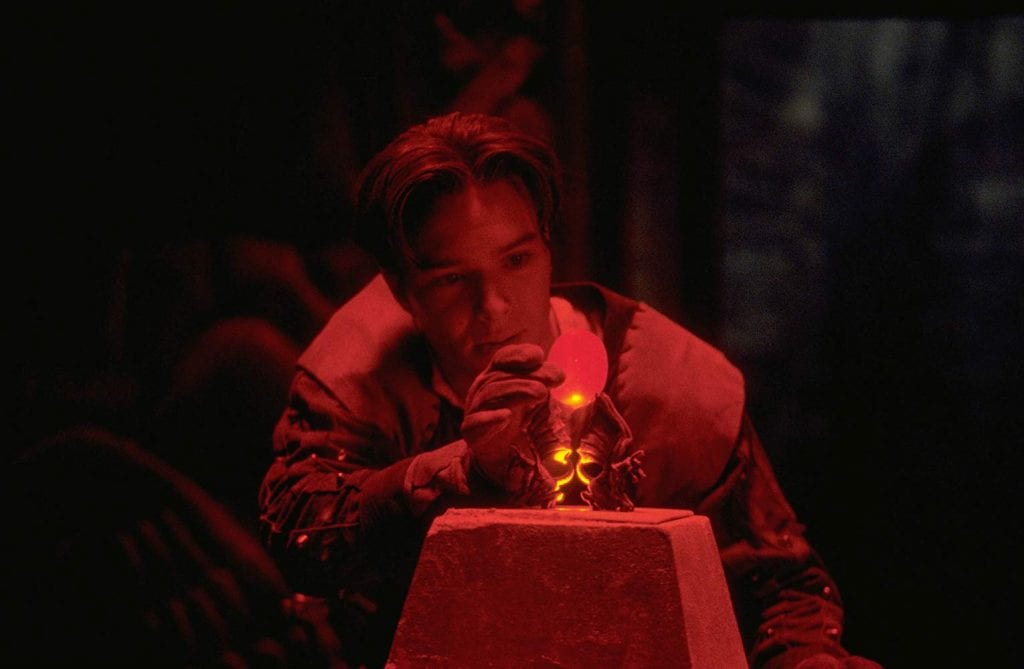
[Ridley strides confidently into the deadly thieves’ guild maze. Tim’s voice-over narrates.]
Tim (GM): Ridley, you turn the corner and enter a dark corridor with a floor made up of old cobblestones. You can’t see the end of the hallway, but the darkness is punctuated by beams of light shining through narrow gaps in the walls.
Andy (Ridley): I know this! I wave my hand in front of the beam of light and then get out of the way.
Tim (GM): A huge axe swings from the gap in the wall, but it crashes harmlessly against the rough-hewn stone where your hand was seconds before.
Mark (Snails): Nice!
Andy (Ridley): I tumble through the corridor, careful to avoid the light as much as possible.
Tim (GM): Roll me a tumble check.
Andy (Ridley): Yes! 18!
Tim (GM): Awesome! You swerve and dive like a champion acrobat. You enter the next room and the door closes behind you. This is a narrow hallway, and the floor is made up of 12×12 inch tiles. Each tile has a painting of an eye on it. Some are red, some are blue, and some are yellow. It seems like there might be some kind of pattern. The door in front of you starts to close, slowly.
Andy (Ridley) [barely containing his excitement]: Are we actually doing this?
Tim (GM): You tell me.
Andy (Ridley): I stab one of the blue tiles with my sword.
Tim (GM): Fire shoots out of the wall two feet ahead of you.
Andy (Ridley): I stab a red tile.
Tim (GM): Nothing happens.
Andy (Ridley): I jump on to a red tile.
Tim (GM): Nothing happens.
Andy (Ridley): I jump onto the next red tile.
Tim (GM): It’s more than 5 feet away. You’ll need to roll me a jump check.
Andy (Ridley): [Rolls dice.] Ugh. I rolled a 3… so with my Jump skill, it’s a 9. Will a 9 do it?
Tim (GM): I’m afraid not.
Mark (Snails): Man, your dice hate you today!
Tim (GM): Just as you are starting to gain confidence in the maze, your foot slips, and you hit the wrong tile with your toe. Fire shoots out from every direction. Roll a reflex save.
Andy (Ridley): [Rolls dice.] Is 15 good enough?
Tim (GM): Yeah. You manage to avoid the flames, but you barely escape in time to avoid the closing door. Before you can catch your breath, the ceiling above you begins to descend. It’s covered in rusty spikes. Roll a perception check.
Andy (Ridley): [Rolls dice.] Hell yeah! Natural 20!
Tim (GM): Ahead of you, you can clearly see the mechanism controlling the ceiling. It looks like an hourglass, and the ceiling seems to be falling at the exact same rate as the sand.
Andy (Ridley): I smash the hourglass with my sword.
Tim (GM): You escape the spike room without a scratch on you.
Andy (Ridley): I knew it! I’m totally Indiana Jones!
Mark (Snails): Watch out for the falling boulder, dude.
Andy (Ridley): I hope not. That would be lame.
[Tim hurriedly scratches out some of his notes.]
Tim (GM): Yeah… lame…
As the audience, we become more invested in the action because we now understand what drives the main character. Andy imagines himself as Harrison Ford, and in this moment, he is just as smooth as the scruffy-looking nerfherder himself.
Is it possible to capture the feel of Dungeons & Dragons on film?
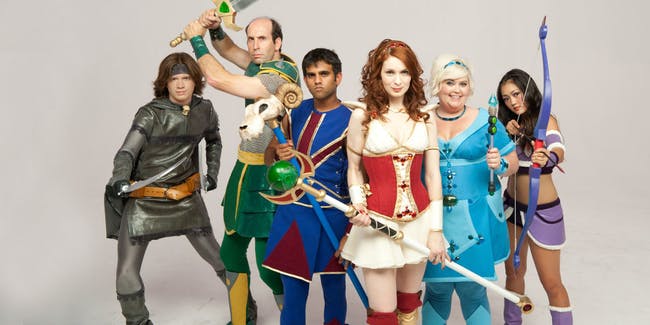
The cult-hit web series The Guild may not technically be about D&D, but it is about role playing and delves into the drama and comedy created by collective storytelling. The Guild rarely steps into the fantasy realm of “The Game” itself, but when we do enter the MMORPG (Massive Multiplayer Online Role-Playing Game), those moments are filled with poignancy. More importantly, the characters’ love for the game is evident in almost every interaction, constantly working its way into their dialogue.
They all refer to each other by their avatar names instead of their real-world ones, and they speak in terms of stats and DPS. When the Guild finally decides to stand up to Zaboo’s overbearing mother, Codex refers to her as a “boss.” The show is full of nods to the cognitive dissonance that comes with spending a lot of time in a fantasy world.
The Guild is fascinating because the framing device isn’t reality nor is it the fantasy of the game. It’s Codex’s vlog-style confessionals. This is a fantastic approach as the production didn’t have the budget to regularly dive into a Computer-Generated world. Instead, we are normalized to the insanity of these obsessive players through Codex’s good-natured, neurotic ramblings. Codex begins one memorable episode with this line: “So, it’s Friday night… still jobless. Yay. I haven’t left the house in a week. My therapist broke up with me… oh yeah, and there’s a Gnome Warlock in my living room sleeping on my couch.” With memorable quotes like this, The Guild effectively blurs the line between fantasy and reality, capturing how it feels to live your best life in-game.
The Gamers: Dorkness Rising: An Hidden Gem
If The Guild is too reality-oriented for your tastes, I recommend the low-budget indie gem The Gamers: Dorkness Rising. This 2008 film nimbly balances the fantasy adventures of its heroes and the mundane drama of the players. The movie focuses on Lodge, a GM trying to finish his 3.5 edition D&D module. Unfortunately, his regular group of players can’t figure out how to complete the adventure, so Lodge doesn’t know how to end his story. Luckily, just as the gamers are about to embark on the same adventure for the third time, one of the players invites his ex-girlfriend, Joanna, to play as well. She turns out to be an unusually skilled gamer, and with her help and the lessons the players and GM learn along the way, the team is finally able to finish the adventure and the module.
The Gamers: Dorkness Rising is full of classic D&D scenarios both around the table and in Lodge’s fantasy realm. Everyone with even a casual relationship with D&D has played with the “rule police” gamer. In this film, that character is Cass, who enjoys pulling out his Player’s Handbook every time he and the GM disagree. And then there’s Gary, who swears that his alignment is Chaotic Neutral, but enjoys killing numerous innocent NPCs without the slightest provocation. And Leo plays a bard who, despite his best efforts, dies constantly. These are real D&D problems that many players can identify with.
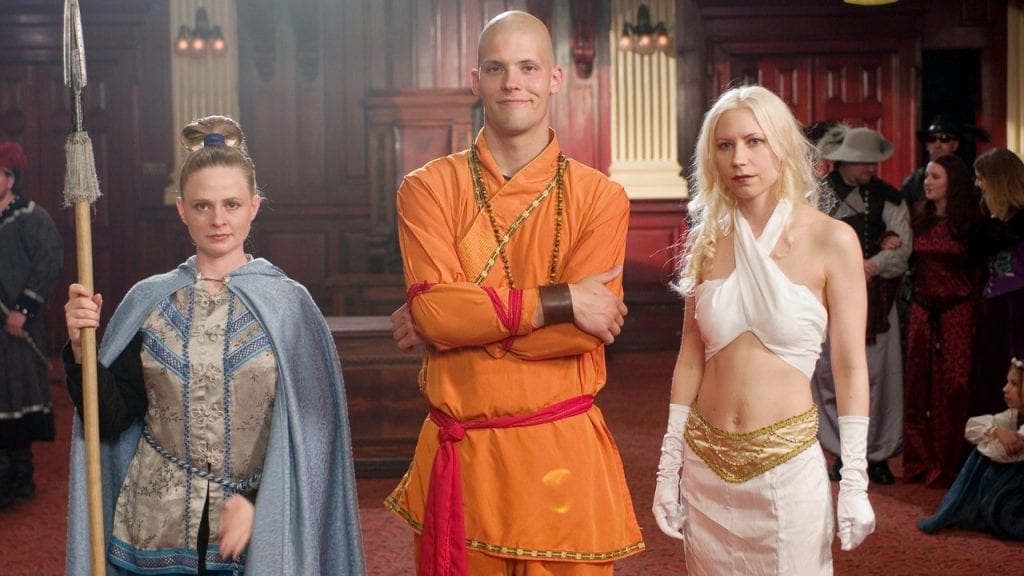
But the real magic of this movie is that these issues are solved in-game. Lodge learns to loosen up and allow his players some freedom by role-playing as a rule-bound paladin. Cass learns that the story can be more important and more fun than the rules by abusing them to great effect. Gary learns to role-play and gets lost in his character. And Leo learns that, while not all skills are particularly effective in battle, all classes have value, even bards.
Not only do the characters and situations feel real, but the writing is hilarious. In one amazing scene, Leo, role-playing as Flynn the bard, must destroy an evil tome:
Lodge: [narrating] Flynn is alone with the Grimoire.
Leo: I stab it! Wait! I BACKSTAB it!
Cass: Good call.
Lodge: Y-y-you can’t backstab it! You can’t *sneak-attack* an inanimate object!
Leo: Why not? It’s PRONE!
Lodge: It doesn’t have a discernible anatomy!
Leo: It’s got a SPINE, doesn’t it?
[Leo rolls a fumble, causing Flynn to stab himself]
Leo: [in shock] Bards suck.
Lodge: That… was unprecedented, Leo.
-The Gamers: Dorkness Rising
The game of Dungeons & Dragons is a made up of memorable moments shared amongst friends. And The Gamers: Dorkness Rising manages to capture that feeling with ease and flair. This film gets my highest nerd recommendation. Watch it.
If you like Podcasts, I recommend the series Not Another D&D Podcast (NADDPOD, for short). And for streaming, Dropout’s Dimension 20 is an absolute joy to watch.
Recommended Reading
If you’re a huge D&D nerd and looking for some light reading to pass the time, I recommend these two webcomics: Order of the Stick and Darths & Droids.
Order of the Stick stars a pretty typical cast of adventurers but manages to stay fresh by regularly breaking the fourth wall and acknowledging character and plot tropes to great comedic effect. For instance, in the very first episode, the heroes openly remark on switching to 3.5 edition.
Darths & Droids is a fascinating read. It is an adaptation of Star Wars as if the characters’ actions were dictated by Dungeons & Dragons players. Not only does this add pathos to the events of episodes 4-6, but it also injects some much needed humor into episodes 1-3. In this iteration, Jar Jar Binks is no longer an irritating and problematic plot cul-de-sac of a character, but instead an imaginative and pushy young girl who regularly hijacks the game, much to the chagrin of the GM and the other players.
Final Thoughts
If you haven’t seen the film Dungeons & Dragons, or it’s been a few years, give it a watch. By adding a dose of meta-textuality, you might find the experience far more enjoyable than you imagined. Will it be a classic? No. Will it stand the test of time? No. Is it good? No. Is it a whole lot of fun? Heck yes! If nothing else, watch it to enjoy the amazingly hammy performance of renowned actor Jeremy Irons.
And, of course, if you haven’t had the chance to play D&D, go out there and find yourself a group. You won’t regret it.



